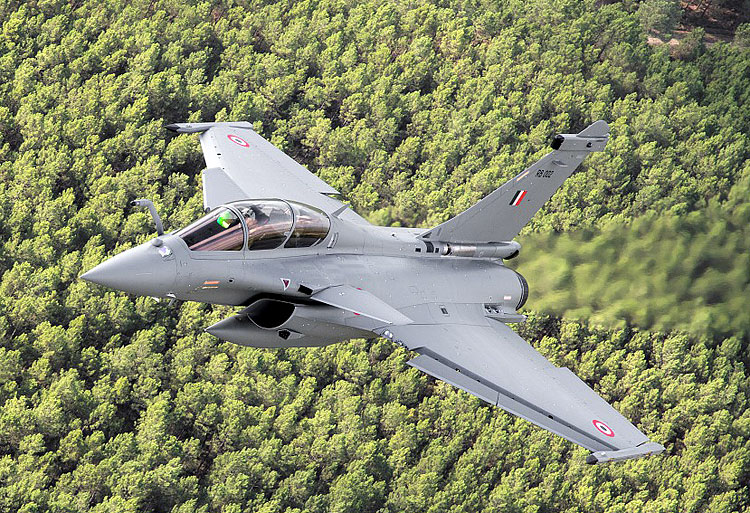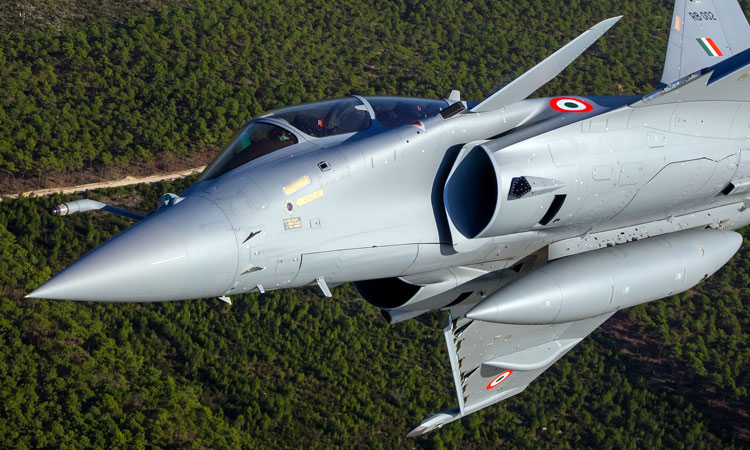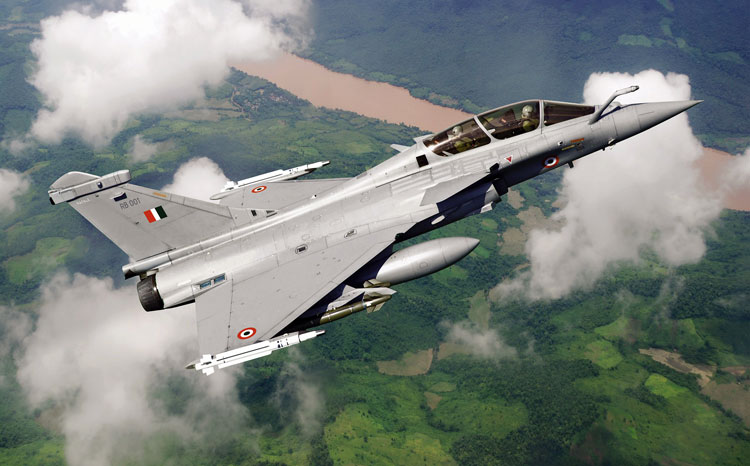INDIAN ARMED FORCES CHIEFS ON OUR RELENTLESS AND FOCUSED PUBLISHING EFFORTS

SP Guide Publications puts forth a well compiled articulation of issues, pursuits and accomplishments of the Indian Army, over the years

"Over the past 60 years, the growth of SP Guide Publications has mirrored the rising stature of Indian Navy. Its well-researched and informative magazines on Defence and Aerospace sector have served to shape an educated opinion of our military personnel, policy makers and the public alike. I wish SP's Publication team continued success, fair winds and following seas in all future endeavour!"

Since, its inception in 1964, SP Guide Publications has consistently demonstrated commitment to high-quality journalism in the aerospace and defence sectors, earning a well-deserved reputation as Asia's largest media house in this domain. I wish SP Guide Publications continued success in its pursuit of excellence.
- Indian Air Force Aims for Full Indigenous Inventory by 2047 — Air Chief Marshal A.P. Singh
- Rajnath Singh assumes charge as Defence Minister for the second consecutive term
- Interim Defence Budget 2024-25 — An Analysis
- Union Defence budget 2024
- Prime Minister Modi Flies in the LCA Tejas
- New Chapter in India-Italy Defence Ties
- Airpower beyond Boundaries
Welcome the Rafale Jets
What is also of significance is that the IAF will be acquiring an enhanced combat capability at a time when military confrontation between India and China along the Line of Actual Control has been escalating despite all political and diplomatic efforts.

The Indian Air Force (IAF) is expected to receive the first lot of five Rafale fighter jets out of the total order of 36 from Dassault Aviation of France by July 27 this year. This will bring to an end the long and agonising wait for the service for nearly two decades for the induction of this platform. What is also of significance is that the IAF will be acquiring an enhanced combat capability at a time when military confrontation between India and China along the Line of Actual Control has been escalating despite all political and diplomatic efforts. There is also talk of the possibility of a two-front war with Pakistan joining hands with China to settle scores with a common enemy.
EFFORTS TO PROCURE COMBAT JETS
As the fleet of MiG-21 fighters acquired for the IAF over a period of time commencing in the mid 1960s from the then Soviet Union, was approaching obsolescence, in the year 2002, the IAF initiated a programme to procure 126 modern, fourth-generation combat aircraft to equip six squadrons. The platform sought by the IAF was dubbed as the Medium Multi-Role Combat Aircraft (MMRCA). However it took five years to settle the issue with the Ministry of Defence (MOD) and the Request for Proposal or the tender was finally issued in August 2007 to which there was response from the aerospace majors of the United States, Russia, European Consortium, France and Sweden. Of the six platforms in the race for the contract, on January 31, 2012, the Rafale combat jet from Dassault Aviation was declared as the winner with the Eurofighter Typhoon losing out on cost considerations.
Unfortunately, after three years of contract negotiations with Dassault Aviation, the project ended up in a stalemate essentially on account of the reluctance of the Original Equipment Manufacturer (OEM) to take responsibility for the quality of the 108 Rafale jets to be manufactured in India by Hindustan Aeronautics Limited (HAL). The OEM was not confident of HAL being able to handle the complex and advanced technologies involved in the manufacture of the Rafale and as such was not prepared to risk the company’s reputation. As the MOD was not prepared to compromise on this issue, the programme to procure 126 Rafale jets encountered an insurmountable impediment. On April 13, 2015, the then Minister of Defence, Manohar Parrikar, announced that the MMRCA tender was effectively dead. The tender was finally cancelled on July 30, 2015, leaving the IAF literally high and dry with its fleet of combat aircraft continuing to dwindle with the phasing out of obsolete platforms.
The Rafale carries a range of potent weapons that would give the IAF an edge over the Air Forces of both China and Pakistan in respect of air strike capability.
As the strength of the combat fleet was reducing continuously and no fresh induction was in site as the MMRCA tender had run aground, on a request from the IAF, Prime Minister Narendra Modi, during his first state visit to France in April 2015, managed to finalise a formal agreement with Francois Hollande, the then President of France for Dassault Aviation to supply 36 Rafale jets in fly away condition. In September 2016, following clearance from the Cabinet Committee on Security, India and France signed an inter-governmental agreement for the acquisition of 36 Rafale jets with delivery to be completed by March 2022. However, the number being relatively small, it will provide only partial relief to the combat fleet of the IAF where deficiency in the combat fleet has been mounting and in no way will it compensate for the cancelled tender for 126 MMRCA. The IAF still hopes for another batch of 36 Rafale jets to be contracted for, but so far there has been no movement in this direction. The IAF will have to make the best use of the 36 Rafale jets that will begin arriving by the end of this month.

THE RAFALE AS A COMBAT PLATFORM
The word Rafale in French means “Gust of Wind” and in a military parlance, it means “Burst of Fire”. The Rafale is a twin-engine, canard delta wing, multi-role combat aircraft produced by Dassault Aviation and is described by the OEM as an “Omnirole Aircraft”. In the 1970s, France was a part of a consortium of European nations in which apart from France, the other members were the United Kingdom, Germany, Italy and Spain that embarked on the development of a fourth-generation combat aircraft. However, on account of some irreconcilable differences, France pulled out of the programme and pursued the development of the Rafale on its own while the European consortium developed the Eurofighter Typhoon. The Rafale technology demonstrator was rolled out in December 1985 and undertook its maiden flight on July 4, 1986.
Apart from the French Air Force, the Rafale is in service with the Air Forces of Egypt and Qatar and India will be on the list in not too distant a future. However, there are a number of other nations that have this platform under consideration for induction.
Arrival of the Rafale jets certainly heralds a new dawn in the combat capability of the fighter fleet of the IAF!
DELIVERY OF RAFALE JETS
As against the original plan for the delivery of four aircraft, Dassault Aviation will hand over five. The lead aircraft which will be a trainer version, will be piloted by the Commanding Officer of No 17 Squadron also called the Golden Arrows Squadron. The rear seat will be occupied by a French pilot. Even though the aircraft has the capability to fly non-stop from France to India, it was not considered desirable as the ten-hour long flight would be unduly stressful for the pilot and could undermine flight safety. Thus the five aircraft flying from France to India will be refuelled in flight by an aerial tanker of the French Air Force before landing in the Middle East at Al Dhafra air base near Abu Dhabi in the United Arab Emirates. In the second leg of the flight from Al Dhafra to India, the aircraft will be refuelled in flight by an IL-78 aerial tanker of the IAF. The seven pilots from the IAF in the first batch have also finished their training at a French airbase while the second batch would be going to France as soon as the lockdown is relaxed in both the countries. Most of the required ground support equipment for the fleet of Rafale jets has already been airlifted to India and more is expected to be delivered in the near future. The first Squadron will be based at Ambala which is 220km from the Indo-Pak border and is regarded as one of the best strategically located airbases of the IAF. The second Squadron will be positioned at Hasimara in West Bengal.

BOOST TO COMBAT CAPABILITY OF THE IAF
The strength of the combat fleet of the IAF has reached an all time low of 29 squadrons as against 42 authorised by the Government for a two-front war. With the phasing out of the MiG-21 Bison fleet over the next few years, the strength of the combat fleet is likely to reduce further as there does not seem to be any major procurement plan on the anvil. Action is in hand to purchase 21 MiG-29 aircraft from Russia and place orders with HAL for 12 more Su-30 MKI. These two acquisitions will add two squadrons to the fighter fleet. In addition, there are plans to place orders for 83 light combat aircraft Tejas Mk 1A, but this is still too far in the future and will make no difference to the state the combat fleet of the IAF has descended into, for some time to come.
In the prevailing situation, arrival of the Rafale, albeit in small numbers, is like a breath of fresh air. Once operational which should not take long, the two squadrons of the Rafale combat jet will significantly enhance the IAF's overall combat capability and will send a clear message to both China and Pakistan. The Rafale carries a range of potent weapons that would give the IAF an edge over the Air Forces of both China and Pakistan in respect of air strike capability. These include the Scalp cruise missile and Meteor next-generation beyond visual range air-to-air missile (BVRAAM) from MBDA that can engage targets at over 150 km and is designed to revolutionise aerial combat. Apart from these missile systems that will be the mainstay of the weapons package, the Rafale jets will come with various India-specific modifications such as Israeli helmet-mounted displays, radar warning receivers, low-band jammers, ten-hour flight data recording, infra-red search and tracking systems. The Rafale has a combat range of 1850km and the variety of weapon systems it is capable of carrying, renders it a highly capable and lethal platform.





